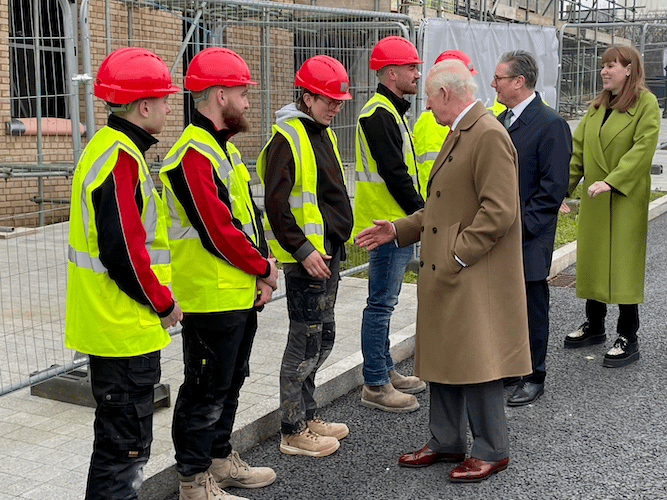Have you heard the one about a King, a Prime Minister and a deputy Prime Minister who all walked into a housing estate?
It could be the start of a very good joke, but in fact it really did happen last week in Cornwall.
His Majesty, along with Sir Keir Starmer and Angela Rayner made a joint visit to the Nansledan housing development near Newquay.

Now, I have reported on many Royal and Prime Ministerial visits to the South West over the years and I cannot recall a single time when Monarch and PM carried out a joint engagement here.
There’s a good reason for that. The Monarch is supposed to be above politics, which is why this visit to Newquay was highly unusual.
The King apparently wanted to show the PM and his deputy the housing development he has taken a keen interest in from his time as the Duke of Cornwall.
The visit came at the same time as the government re-stated its determination to build more houses, one-and-a-half-million more by the end of this parliament.
It’s a tall order. During every election campaign I covered on radio and TV, every party promised to build more houses, even the Greens!
In fact during one televised election debate I had to correct the Green candidate on her party’s policy on housing when she missed a couple of noughts off the end of the number of new houses they were proposing.
It was a slip of the tongue because she was very nervous and I felt bad about correcting her, but it was important to ensure our viewers had the correct information.
Almost everyone recognises the need for more housing developments such as the one the King is keen to champion in Cornwall. The problem is successive governments have rarely been able to deliver the numbers they promised.
So, will it be any different this time?
On the day of the Royal walkabout in Newquay I woke up as usual to the six-fifteen business report on BBC Radio Four. The boss of one of the major house builders was on and was doubtful whether the government could hit its targets.
It’s the usual combination: lack of skilled workers, planning delays and lack of funding for social housing.
But the government seems determined to cut through the planning and environmental red tape this time.
After years of being told we shouldn’t build on the greenbelt, we shouldn’t disturb the bats, or flatten wild orchids, suddenly everything and anything is up for grabs.
I can’t see it being as easy as that. Objections to housing developments became a running theme when I was presenting BBC Spotlight.
I have lost count of the number of protests we covered where placard-waving residents descended on a local village hall to have it out with the poor hapless planning officer who’d been sent to smooth things over.
The most memorable was Sherford, the huge development on the Eastern side of Plymouth. It was in the planning stage for years and faced formidable opposition from a highly organised and vocal campaign group.
It dragged on for so long that I genuinely believed it would never happen. But in the end we reported on every stage of its development right through to the vast community it has become today.
And it is vast; much bigger than I ever anticipated it would be. I got lost in it once. I cut across country on a back road from the South Hams to try to get back on to the A38 and ended up in Sherford, I thought I’d never escape the maze of roads which all started to look the same.
It’s a similar situation with Cranbrook near Exeter. It’s not just another housing estate, it’s a completely new town.
Depending on your point of view these are either much-needed houses or a blot on the once green and pleasant land around Plymouth and Exeter.
This is the dilemma the government will face as it tries to increase house building. Despite widespread recognition of the need to build more houses, most of us don’t want them near our own homes.
My first little starter home in Truro was on a housing estate near Treliske hospital. I thought I had done the deal of the century because the back of the house opened onto fields and the pretty valley below. But it didn’t last.
Within a year of moving in the bulldozers were on the other side of the hedge and my view was replaced with brick walls.
It was devastating and I can fully sympathise with those who want to preserve their view and their peace and quiet.
I almost fell into the same trap years later when I was looking for a new home in South East Cornwall. I was considering a house at Carkeel near Saltash. It looked out onto green fields criss-crossed with traditional Cornish hedges. Not anymore though.
Those green fields are now known as “Treledan”, a huge housing development near Carkeel roundabout.
That’s the other issue with all this proposed house building: how will roads and other infrastructure cope? I now regularly have to queue on the new roundabout serving Treledan, and it will only get busier as more houses are built there.
It’s going to be a bruising battle between a government determined to cut through red tape and local objections, and those who want to preserve our green and pleasant land.
I wouldn’t like to bet on the outcome. I don’t underestimate the will of the government, but experience has also taught me not to underestimate the strength of ‘people-power’ when it comes to planning protests.
Bye for now!




